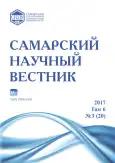Some results of petrographic studies of ceramics from the settlement Toksanbay
- Authors: Shevnina I.V.1, Loshakova T.N.2
-
Affiliations:
- Kostanay State University named after A. Baitursynov
- A.Kh. Margulan Institute of Archaeology
- Issue: Vol 6, No 3 (2017)
- Pages: 216-222
- Section: 07.00.00 – Historical Sciences and Archaeology
- URL: https://journals.rcsi.science/2309-4370/article/view/22098
- DOI: https://doi.org/10.17816/snv201763222
- ID: 22098
Cite item
Full Text
Abstract
The research is devoted to the studies of raw materials and molding masses of ceramic products from the settlement Toksanbay. The purpose of the research was to study the technological aspects taking place in the course of ceramic vessels production, as well as in-depth study of the raw materials and molding masses of pottery ceramics of the settlement. During the research of samples, in addition to petrographic analysis, fragments of ceramics were studied using the binocular microscopy method, chemical experiments were carried out (using a micromethod) with the use of ammonium molybdenum, hydrochloric acid, and microenacts were checked for iron in the composition of the crock. The received result revealed that as the raw material ferruginous clay was used, and the chemical reaction to Fe of all fragments turned out to be positive. The original clay contains sand, besides this, sand feldspars, fragments of sandstones, silicified schists and epidote are noted in the sand composition. Three recipes of molding masses were revealed. The organics is stated in the form of silicified voids. The composition of organic matter showed carbonate-siliceous or carbonate-phosphate. The microreaction analysis using ammonium molybdenum (МоН4)2АmО4 determined the presence of a phosphate type in organic samples. From the organic fillers, a part of the studied samples revealed hollows of round and oval shape from the burnt organics. The study of the pottery of the settlement will be continued but it can be argued that the Toksanbay potters used local clay, and the most common impurity was organogenic limestone.
Keywords
Full Text
##article.viewOnOriginalSite##About the authors
Irina Victorovna Shevnina
Kostanay State University named after A. Baitursynov
Author for correspondence.
Email: shevnina_i@mail.ru
researcher of Archaeological Laboratory
Kazakhstan, KostanayTatyana Nikolaevna Loshakova
A.Kh. Margulan Institute of Archaeology
Email: loshakovat@mail.ru
senior researcher
Kazakhstan, AlmatyReferences
- Круг О.Ю. Применение петрографии в археологии // Археология и естественные науки. М., 1965. С. 146-151.
- Жущиховская И.С., Залищак Б.Л. Петрографический метод в изучении древней керамики (на материале неолитических средневековых культур Приморья) // Методы естественных наук в археологическом изучении древних производств на Дальнем Востоке СССР. Владивосток, 1986. С. 55-67.
- Самашев З., Ермолаева А.С., Тепловодская Т.М. Исследования поселения эпохи палеометалла Токсанбай в Арало-Каспийском междуморье // Комплексные общества Центральной Евразии в III-I тыс. до н.э. Региональные особенности в свете универсальных моделей: мат-лы междунар. конф. (25 августа - 2 сентября 1999 г.). Челябинск - Аркаим: Изд-во Челябинского госуниверситета, 1999. С. 178-185.
- Самашев З.С., Ермолаева А.С., Лошакова Т.Н. Поселение эпохи палеометалла Северо-Восточного Прикаспия // Вопросы истории и археологии Западного Казахстана. Уральск: Западно-Казахстанский центр истории и археологии, 2004. Вып. 3. С. 125-153.
- Самашев З., Ермолаева А.С., Лошакова Т.Н. Поселения токсанбайского типа на северо-восточном Устюрте // Проблемы изучения культур раннего бронзового века степной зоны восточной Европы: сб. научных трудов. Оренбург: Изд-во ОГПУ, 2009. С. 159-167.
- Лошакова Т. Поселенческие комплексы эпохи бронзы северо-восточного Устюрта // Новые материалы и методы археологического исследования: мат-лы II междунар. конф. молодых ученых. М.: ИА РАН, 2013. С. 78-79.
- Самашев З.С., Ермолаева А.С., Лошакова Т.Н. Орудия труда и медеплавильное производство поселения Токсанбай (Северный Устюрт) // XV Уральское археологическое совещание: тез. докл. междунар. археол. конф. Оренбург, 2001. С. 109-110.
- Самашев З., Ермолаева А.С., Лошакова Т. К вопросу о культурной принадлежности домостроительных традиций на поселении Токсанбай // Историко-культурное наследие Арало-Каспийского региона: мат-лы II междунар. науч.-практ. конф. (26-28 августа 2010 г.). Актау, 2010. С. 47-55.
- Лошакова Т.Н. Псалии поселения Токсанбай // Культурогенез позднего бронзового века Волго-Уралья: мат-лы междунар. конф. Самара, 2014. С. 81-88.
- Шевнина И.В., Лошакова Т.Н. Керамика из жилищ с поселения Токсанбай // VII Исторические чтения памяти Михаила Петровича Грязнова. Омск, 2008. С. 270-278.
- Гребенщиков А.В., Деревянко Е.И. Гончарство древних племен Приамурья. Новосибирск, 2001. 120 с.
- Мыльникова Л.Н. Гончарство неолитических племен Нижнего Амура. Новосибирск: ИАиЭ СО РАН, 1999. 160 с.
- Бобринский А.А. Гончарство Восточной Европы. М.: Наука, 1978. 272 с.
- Глушков И.Г. Керамика как археологический источник. Новосибирск: ИАЭт СО РАН, 1996. 328 с.
- Бобринский А.А. Гончарная технология как объект // Актуальные проблемы изучения древнего гончарства (коллективная монография). Самара, 1999. С. 75-106.
- Цетлин Ю.Б. Основные направления и подходы к изучению органических примесей в древней керамики // Актуальные проблемы изучения древнего гончарства: коллективная монография. Самара, 1999. С. 110-140.
Supplementary files









